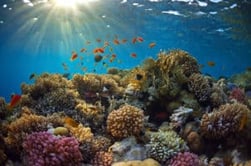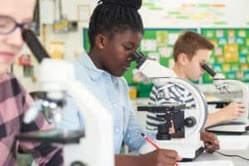Competition in Ecosystems Inquiry Lab
Middle School Inquiry Lab on Competition in Ecosystems
In this lab, students will compare the interactions of organisms by researching a northern forest ecosystem. They will then compare the roles of that ecosystem to the roles of another to predict organism relationships.
Each inquiry lab will contain an essential question that will drive the lesson and make students think. For this lesson, the essential question is:
- How can we predict the ways organisms will interact with each other in different ecosystems?


BACKGROUND INFORMATION AND MATERIALS LIST:
Students will begin the lab by reading the essential question and background information. This can be done individually, as lab groups, or as a whole class. Personally, I would do it in lab groups and then do some whole class formative checks before digging into the lab.
Materials List:
- Internet access
PROCEDURE:
Students are provided a website and asked to study the list of organisms from a northern forest ecosystem. They will uncover information such as predator/prey relationships, food habits, and symbiotic relationships between each of the organisms.
All of the information will be collected on the data table below.
CHECK FOR UNDERSTANDING:
At this point in the lab, students will be checked for understanding by answering questions about their findings. Here are a few that come with the lab:
- Describe a competitive relationship you found:
- Describe a predator-prey relationship you found:
- Describe a symbiotic relationship you found:
Students will resume the lab by applying their new knowledge to the diagram pictured below.
In order to extend the learning, the students will apply their knowledge to another ecosystem and make some predictions between the two. In the full lab, a hot desert ecosystem diagram is provided.
They will once again check for understanding by answer questions about the competition in ecosystems lab.
- On what did you base your predictions for the hot desert organisms?
- Why would the relationship between pollinators and flowers be the same in multiple ecosystems?
- What is a symbiotic relationship?
- List the three basic types of symbiotic relationships.
CONCLUSION
Students will go back to the essential question and write a CER (Claim, Evidence, Reasoning) to conclude the lab. Once completed, students will reflect back on their learning by answering the following questions.
- If fruit trees exist in an ecosystem, what kind of organisms would you expect to find? Why?
- Mountain lions are carnivores, not omnivores, that live in the desert. Would they fit into the patterns of the northern forest ecosystems? Why or why not?
MODIFIED AND INDEPENDENT INQUIRY VERSIONS
All of the Kesler Science inquiry labs come with three different modification levels. Each lab is differentiated using the icons below.
.webp?width=750&height=382&name=Screen-Shot-2018-12-03-at-9.48.46-AM%20(1).webp)
STANDARDS ALIGNMENT
NGSS: MS LS 2-2 - Construct an explanation that predicts patterns of interactions among organisms across multiple ecosystems.
Download Over $100 in FREE Resources
For Middle School Science
Simply create a login below and gain immediate access to a selection of our Kesler Science product line worth $100 - for FREE. There's a full version of every product type! You'll also join tens of thousands of middle school science teachers who receive timely tips and strategies straight to their inbox.




